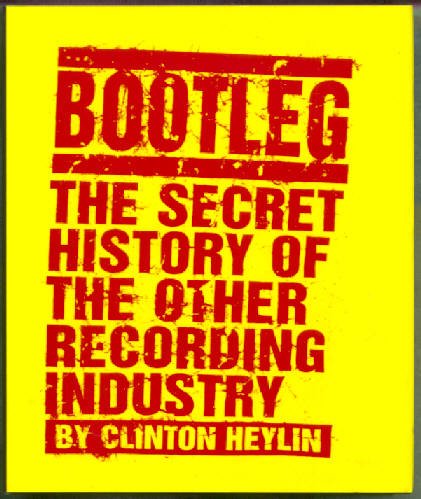Clinton Heylin: Bootleg: The Secret History of the Other Recording Industry (1995)
Filed under book | Tags: · music, music history

In Bootleg: The Secret History of the Other Recording Industry, Clinton Heylin examines the entire modern history of this underground culture: from what defines a bootleg and its complex and protean legal status, to a full history of bootlegs’ production and distribution, to what’s contained on some of the most notorious bootlegs and how to find them. Along with many illustrations of the creative packages, this is the whole story of the $250 million industry that sustains itself on the great figures of rock music and their biggest admirers.
Publisher St. Martin’s Press, New York, 1995
ISBN 0312142897, 9780312142896
448 pages
Seth Kim-Cohen: In the Blink of an Ear: Toward a Non-Cochlear Sonic Art (2009)
Filed under book | Tags: · art, art history, music, music history, musique concrète, ontology, phenomenology, rock'n'roll, sculpture, sound, sound art

“An ear-opening reassessment of sonic art from World War II to the present.
Marcel Duchamp famously championed a “non-retinal” visual art, rejecting judgments of taste and beauty. In the Blink of an Ear is the first book to ask why the sonic arts did not experience a parallel turn toward a non-cochlear sonic art, imagined as both a response and a complement to Duchamp’s conceptualism. Rather than treat sound art as an artistic practice unto itself—or as the unwanted child of music—artist and theorist Seth Kim-Cohen relates the post-War sonic arts to contemporaneous movements in the gallery arts. Applying key ideas from poststructuralism, deconstruction, and art history, In the Blink of an Ear suggests that the sonic arts have been subject to the same cultural pressures that have shaped minimalism, conceptualism, appropriation, and relational aesthetics. Sonic practice and theory have downplayed – or, in many cases, completely rejected – the de-formalization of the artwork and its simultaneous animation in the conceptual realm.
Starting in 1948, the simultaneous examples of John Cage and Pierre Schaeffer initiated a sonic theory-in-practice, fusing clement Greenberg’s media-specificity with a phenomenological emphasis on perception. Subsequently, the “sound-in-itself” tendency has become the dominant paradigm for the production and reception of sound art. Engaged with critical texts by Jacques Derrida, Rosalind Krauss, Friedrich Kittler, Jean François Lyotard, and Jacques Attali, among others, Seth Kim-Cohen convincingly argues for a reassessment of the short history of sound art, rejecting sound-in-itself in favor of a reading of sound’s expanded situation and its uncontainable textuality. At the same time, this important book establishes the principles for a nascent non-cochlear sonic practice, embracing the inevitable interaction of sound with the social, the linguistic, the philosophical, the political, and the technological.
Artists discussed include: George Brecht, John Cage, Janet Cardiff, Marcel Duchamp, Bob Dylan, Valie Export, Luc Ferrari, Jarrod Fowler, Jacob Kirkegaard, Alvin Lucier, Robert Morris, Muddy Waters, John Oswald, Marina Rosenfeld, Pierre Schaeffer, Stephen Vitiello, La Monte Young.”
Publisher Continuum, New York/London, 2009
ISBN 082642970X, 9780826429704
296 pages
Reviews: Laura Paolini (MusicWorks, 2010), Will Scrimshaw (2010), Brian Kane (NonSite, 2013).
PDF (updated on 2020-7-13)
Comments (5)Larry Polansky: The Early Works of James Tenney (1983)
Filed under book | Tags: · 1960s, composing, computer music, music, music history, music theory

“James Tenney was a composer and influential music theorist. He studied piano with Eduard Steuermann and composition with Chou Wen-chung, Lionel Nowak, Paul Boepple, Henry Brant, Carl Ruggles, Kenneth Gaburo, Lejaren Hiller, John Cage, Harry Partch, and Edgard Varèse. He also studied information theory under Lejaren Hiller, and composed stochastic early computer music before turning almost completely to writing for instruments with the occasional tape delay, often using just intonation and alternative tunings. Tenney’s notable students include John Luther Adams, John Bischoff, Peter Garland, Larry Polansky, Charlemagne Palestine, and Marc Sabat. He performed with John Cage, as well as with the ensembles of Harry Partch, Steve Reich, and Philip Glass.” (source)
Published in Soundings #13, edited by Peter Garland
181 pages
via Larry Polansky
Comment (0)
